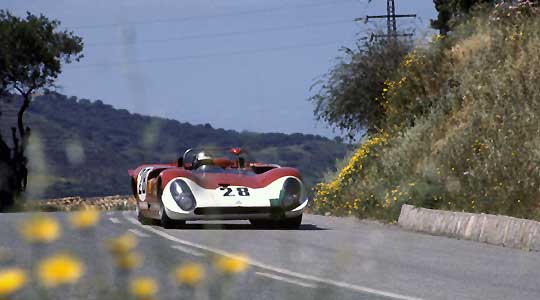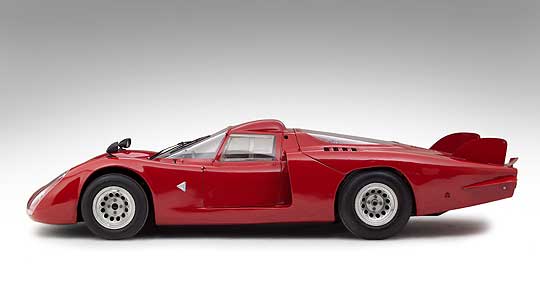
While Ferrari and Porsche took centre stage in late 60s/early '70s endurance racing, Alfa Romeo, a company with a racing tradition dating back to the 1920s, was building up a presence that was to dominate the circuits by 1975. A collection of sports-racers from this exciting 10-year period formed a central part of the fabulous, now sadly closed, Rosso Bianco Collection at Aschaffenburg in Germany.
The eight cars comprise a 1967 2-litre V8 T33 Periscopica (the model which launched this legendary series), a streamlined 1967 T33 Mugello Spyder of the same vintage, a rare 1968 T33/2 Le Mans coda lunga (long tail) plus examples of both that year’s coda corta (short tail) T33/2 Daytona Coupe and the open T33/2 Targa Florio Spyder, a 1970-71 3-litre V8 T33/3 Spyder Corsa, an example of the wickedly pugnacious multi-tubular chassised 1972 T33/TT/3 Spyder, and the swansong 1976-77 turbocharged flat-12 Alfa Romeo T33/SC/12 Spyder, still in its evocative Fernet Tonic colours.
 1967 Alfa Romeo T33/2 ‘Periscopica’ Spyder |
 1967 Alfa Romeo T33/2 ‘Mugello’ Spyder |
The cars have not run for some time but have been well preserved within the Rosso Bianco museum display and are generally considered to be in fine condition overall, several examples having been previously restored while others remain highly original. This is particularly true of the imposing T33/SC/12 - the most complex, most powerful and by far the most formidable of these machines with its combination of late-series monocoque chassis and twin-turbocharged flat-12 engine.
 1968 Alfa Romeo T33/2 Targa Florio Spyder |
 1968 Alfa Romeo T33/2 ‘Daytona’ Coupe |
This series of Alfa Romeo quasi-works racing sports-prototype cars originated in 1966-67 with ex-Ferrari Chief Engineer Ing. Carlo Chiti and his team of engineers at Autodelta SpA. The early 2-litre V8 T33s like the Periscopica derived much from contemporary Formula 1 practice, while their ‘H’ plan-form chassis structures embodied frontier-technology by employing large-diameter cast-magnesium frame members to form the ‘H’.
Subsequent models saw the original 2-litre, 4-cam, V8 fuel-injected engines enlarged from 2-litres, through 2.5 to a full 3-litres capacity, and even 4-litre CanAm units followed. Stressed-skin monocoque chassis replaced the original cast-magnesium ‘H’ frames in the 1970 T33/3s, followed by the modern ‘Birdcage’ multi-tubular chassised T33/TT/3 and a return to the aluminium-skinned monocoque in Alfa Romeo's most sophisticated form for the SC/12.
 1968 T33/2 ‘Le Mans’ Longtail |
 1970/71 Alfa Romeo T33/3 ‘Targa Florio’ |
In period these Italian-red works team cars confronted the stiffest opposition the racing world could throw at them, competing wheel-to-wheel with Ferrari Dino 206Ss and Ferrari 312PBs, Porsche 907s, 910s and 908/3s, and even on occasion duelling with the mighty Porsche 917s and Ferrari 512s.
These are the natural heirs to the Alfa Romeo racing heritage embodied in the immortal 8C-2300s and Tipo B Monoposto cars of the 1930s, and when the flat-12-engined T33s won the 1975 World Championship of Makes they followed in the footsteps of the classical P2 cars of 1924-25 which had first added the World Championship laurel wreath to Alfa’s famous badge.
 1972 Alfa Romeo T33/TT/3 |
 1976 Alfa Romeo T33/SC/12 Spyder |
The Rosso Bianco Collection Alfa Romeo Tipo 33 family is to be offered for sale by Kidston SA in Geneva - www.kidston.com.

Text - Doug Nye
Photos - Kidston SA
ClassicInside - The Classic Driver Newsletter
Free Subscription!


